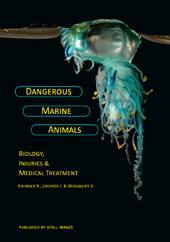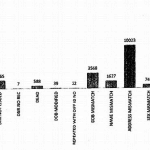The waters surrounding the Maldives have an international reputation for spectacular diving that entices hordes of visitors to the country every year.
Much of the credit for this goes to the prolific marine life, which ensures even the sharks are friendly – a flailing tourist is a difficult meal when all a shark has to do is open its mouth for the fish to swim inside.
But when injuries at the fins, spines, teeth and tentacles of marine life do occur, local medical facilities have proven ill-prepared to deal with them.
When local marine biologist Verena Wiesbauer Ali visited an island doctor following a nasty sting from a Pelagia panopyra (Purple Jellyfish), he asked her why she had eaten one.
“I had swam through a soup of jellyfish and the itching was so bad I couldn’t sleep,” she recalls.
The doctor treated the symptoms with an IV and some anti-histamines, but later told her there was little literature available on the country’s dangerous or toxic marine life.
“His diagnosis was ‘fish stinger’,” she says. “I felt sympathetic so I took in a photo of the jellyfish the next day and the doctor began to ask a lot of other questions.”
Much of the literature Verena found was in German, and the treatments were varied. Conventional wisdom, such as applying vinegar to a jellyfish wound to deactivate the poison, was not always the case: “If you apply vinegar to the sting of a Portugese Man o’ War, it can have the opposite effect,” Verena discovered.
Researching further she did find a great many local stories along the lines of “‘there’s an animal this shape and this wide, and if you touch it your arm will fall off.'”
Assembling a team of doctors and marine biologists, including Dr Jens Lindner and Dr Reinhard Kilinger, she decided to write the Maldives’ first reference to dangerous, venomous and poisonous marine animals.
“We felt the need for a doctor’s reference that gives a detailed description of symptoms and recommendations for medical treatment,” she says, adding that one important inclusion was a Dhivehi reference dictionary for the local names of different species and dangerous seafood, such as sea urchins.
Beyond medical applications, Verena says the authors tried to make the book accessible “for anyone coming into contact with the sea, from snorkelers and divers to tourists and marine biologists.”
It includes information and treatment instructions for creatures like lion fish (“from a group known as scorpion fish that have quite strong venom – the display they make by spreading their fins is to show prey ‘I’m poisonous'”), sharks (“there are 35 species in the Maldives, including tiger sharks which can be more aggressive”,) and sting rays.
“Sting rays lie on the sea floor feeding on mollusks,” Verena explains. “They will move away from a person, but if stepped on they have venomous spines in their tail that can be fatal, as with [Australian TV personality] Steve Irwin. Most people are hit in the shin, but the spine is serrated and it normally has to be pushed through the limb; you can’t pull it, although now we can operate it out.”
Even seemingly-harmless surgeon fish can cause painful injuries: “They have a blade at the base of their tail fin.”
At a presentation on the book to doctors and nurses at Indira Gandhi Memorial Hospital (IGMH) today, president of the Maldivian Medical Association Dr Azeez Yoosuf noted that while Male’s roads caused more injuries than the country’s waters, “there is a lot of inappropriate treatment of injuries caused by marine creatures.”
“We come across island hospitals where wounds caused by sting rays have been nicely stitched up, but because of the toxins the wound becomes necrotic. It’s better to keep the wound open, but the tendency is to stitch it,” he explains.
Surgeon fish injuries were surprisingly common, he added. “You can safely swim through a school of surgeon fish. But curious tourists sometimes try to pat them and get a big cut on their hand, which can become a problem because the [tail] can be covered in a lot of slime.”
As for the tremendously poisonous stonefish, “we don’t have the anti-venom, it’s only available in Australia. We just treat the pain.”
Despite their fearsome reputation, shark attacks were very rare, he said.
“The only shark bite I’ve seen was on someone who caught one and tried to get the fishhook out by putting his hand in the [live] shark’s mouth.”
The traditional treatment for jellyfish stings, he noted, was “hot urine or alcohol.”

“Dangerous Marine Animals – Biology, Injuries & Medical Treatment” (Kikinger, Lindner, Wiesbauer-Ali 2009) is printed and published in the Maldives and is available directly from the publisher Atoll Images, Ma. Shah, Dhidhi Goalhi, Male’ (3341643).
 (6)Dislikes
(6)Dislikes (1)
(1)




As a Maldivian i greatly appreciate this intellectual piece of work, i thank the authors.
I must have this book.
I shall buy this book. Looks awesome.
Thanks for covering this, Minivan, and IGMH for the great organization of the event. A lot of doctors and nurses showed interest in the book and purchased it.
This book should be read by everyone who is using the sea - to be aware and avoid dangerous marine animals.
And yet again a foreigner does the work which dhivehin shouldve done long time ago. thanks verena
You can just drop by at our office (Ma. Shah, Dhidhi Goalhi (close to Evince, opposite of Food Bank Restaurant), ring the bell and ask for my name. It's MRF 120.
Verena,
thank you so much for the great book.
There is no reason why this is a news item except to help this person to sell a book. I wonder if Minivannews would help a locals the same way.
The title 'dangerous Maldives marine life' is certainly not a good one for the tourism industry. There would be poisonous species everywhere, but we don't have species like the poisonous sea snakes in the pacific.
My point here is that this book is very much a foreigners perceptive, written to a foreign audience by distorting fears about Maldives marine life, which we have learned coexisted for thousands of years.. there is no additional contribution in the book to understanding science.
BTW, I hope the drug related violence in Male does inspire some one (including a tourist) to write a preventive book. That would surely be of help to the locals, even if there is not so much money to be made out of the topic.
Most welcome! I hope it will be useful for everyone using the sea in any way - it should not frighten, instead make people aware of what is out there and how to avoid - potentially - dangerous marine animals.
oh drop it Aisha! Didn't you notice that its "yet again" another foreigner but who IS MARRIED to a Maldivian. So she is practically a Maldivian.
Anyways, what's with this attitude dissing Maldivians and their achievements?
On seeing your comment one might also add, yet again another local who is prey to neo-colonialisation.
It is great that a book that this article refers is being published.
But it is worrying that Minivannews is acting as its marketing agency. I would like to ask whether Minivannews does the marketing for those written by expatriates only?
I would like to point the following:
1. Underwater life, navigation and alternative medicine has been a huge part of Maldivian life.
2. Unknown to many, Maldivians have local names for all that was found in their environment. Unfortunately, they are not documented. Even if they are documented, they remain within the reach of few only.
3. Maldivians are aware of the dangers and risks by these sea creatures on human life. They have effective home made remedies for that and have used them with effective results.
4. The problem with Maldives is that almost all its cultural knowledge is lost or is on its way to get lost.
I wish someone would write a book with all the cultural knowledge on our underwater life. I am sure JJ Robinson will do the marketing on Minivannews for free.
Dear all,
As Yaseen said it right, I am not a foreigner, but married to a Maldivian, converted, and therefore not an expatriate as I was before. So let's say a half-Maldivian as my passport did not change. But I think that does not matter. I am sure Minivan will cover Maldivians' work like mine. The publisher of this book has invited Minivan to cover the book presentation and that is what they did.
It is true that the author's aim is to sell the book - logic - but if you think we are making a lot of money out of it - nope! A few Rufiyyaa per book I am getting. My personal aim is to make people aware of what is out there in order to avoid injuries inflicted by marine animals. I am earning my living from my regular job.
@ Ahmed Azim: We do have poisonous sea snakes in the Maldives, as it is also mentioned in the book, e.g. Pelamis platurus, the "Yellow bellied sea snake". Until recently there was one in a tank at Seafood Restaurant, Villingili, but I am not sure if it is still there, I will have to check. Got a photo of it (and a nicer one is in the book). Maldivian fishermen will know. I have DVDs of Hans Hass collecting them from the Maldives in the 1960 as well.
@Yaseen - the "local who is prey to neo-colonialization" - you must be referring to my husband? - He is smiling.
@Shaya: may I comment on your post:
1. Correct, I spoke to a lot of locals about it
2. You said local names are not documented - I did, they can be found in the book.
3. Home remedies: I did mention Maldivian home remedies in the medical aspects of the book (e.g. Rihaakuru)
4. Also correct. I would also like to see a Maldivian publishing a book with the cultural knowledge of the Maldivian underwater life. Not only underwater life actually, also about dhivehi bes. I would buy it. Love to visit dhivehi besverin.
Oh by the way, may I recommend a "cultural Maldivian" book which has lots of traditional stories collected:
"The Maldive Islanders", by Xavier Romero-Frias, published by Nova Ethnographica Indica.
Thank you for your positive and also critical comments.
I have always thought Minivannews is the most professional news source in Maldives but it seems I am wrong.
I do not think that Minivannews should serve as the personal blog of the author of the book referred here.
This is unacceptable.
An excellent piece of work by a truly dedicated and professional marine biologist. This publication has definitely made us all feel safer.
While expressing much gratitude for this important contribution of knowledge about our marine life, I wish Mrs.V.W.Ali(MSc),continued success in her work!
This is very informative piece of work by some one who knows EXCATLY what she is saying. Any one who read through will know it’s very much in the context of Maldives, I recommend who haven’t to do so before commenting.
Great work Venera W. Ali.
my opinion is that... Verena Wiesbauer Ali.. has done a grate job..!, its a very handy book, with lot of important knowledge..!
i do recommend this book to all the shell collectors in the Maldives.
shaheem Najeeb.
Hrmm well i ll be looking forward to reading this book.
Running a diving school - since 1993 - in Europe I greatly appreciate this book!!! Finally there is a book full of information for a diving tourist who has no clue about hazards in the sea. Without exaggerating or banishing fear. A book you can easily take with you - wherever you travel!
I got to know Verena some years ago as an engaged stundent for environment in my diving school. Nowadays I (proudly) sell her book giving other divers a lot of useful information. On the way from freshwater to a happy&healthy divingholiday in Paradise. Thank you, Verena!
Thank you for your comments, but please keep in mind that credits go especially to Dr. Kikinger & Dr. Lindner - I am just one of three authors!
This is an excellent book, covering a topic which is eminent for everybody swimming, snorkeling or diving in the Maldive area. Not only do the authors present their own phantastic photographs of the varous toxic animals, they also give precise biological information about the current knowledge of the various species, and the potential ways for medical treatment.
As a biologist I admire such books who give beside scientific information also a practical meaning and application for daily life. This book should be alerted to anybody interested to plunge into maldivian waters.
i might read those books they sound very interesting. (studying marine biology). and also traing for olympic swimming at the same time. the book might come in handy.